Your sunroom holds untapped potential as a thriving indoor garden oasis. You’ll discover how to transform this light-filled space by selecting the right plants, creating dynamic displays, and maintaining a balanced arrangement that maximizes both beauty and functionality. Whether you’re working with a compact 8×10 space or a sprawling 20×30 sunroom, these eight professional styling techniques will help you craft an organized, visually striking plant sanctuary that draws guests in and keeps them wondering what’s around the next corner.
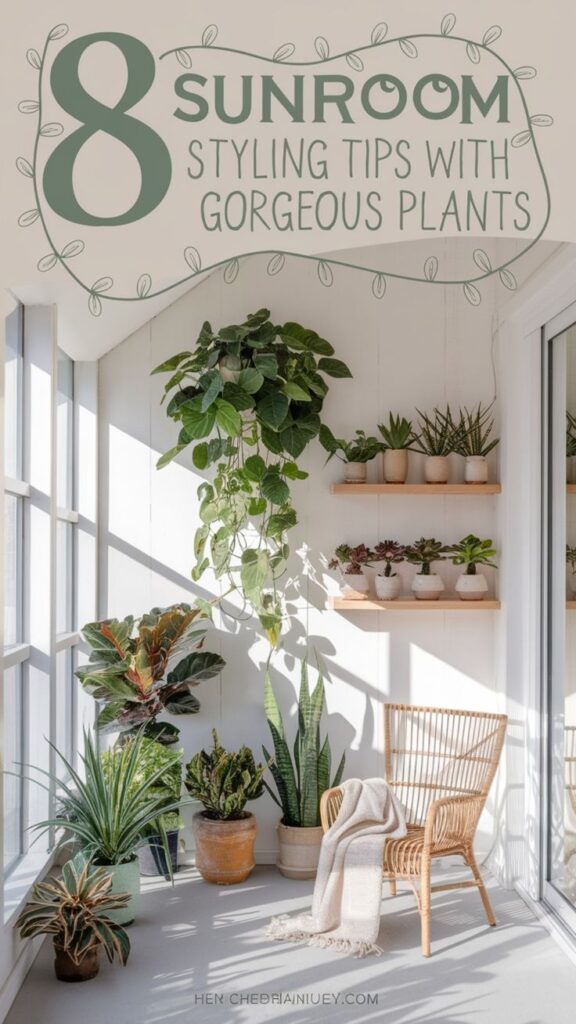
Contents
- 1 Choose Plants That Love Bright, Indirect Light
- 2 Create Visual Height With Multi-Level Displays
- 3 Mix Leaf Textures and Shapes for Interest
- 4 Group Plants in Odd Numbers
- 5 Incorporate Hanging Baskets and Trailing Vines
- 6 Define Zones With Strategic Plant Placement
- 7 Balance Large Statement Plants With Smaller Varieties
- 8 Add Decorative Pots and Natural Elements
Choose Plants That Love Bright, Indirect Light
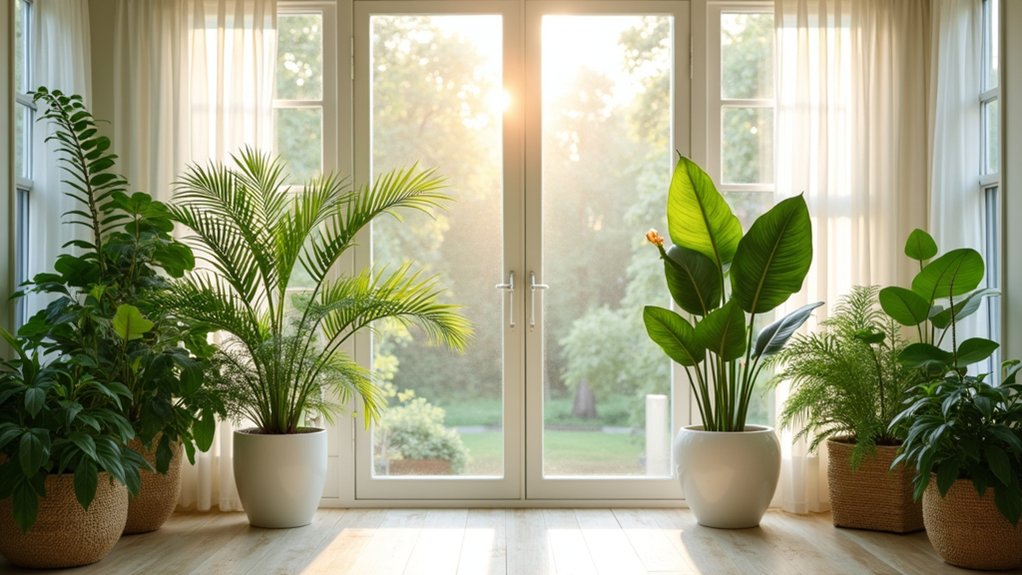
Selecting plants that thrive in bright, indirect light is crucial for creating a lush and vibrant sunroom environment. Many indoor plants naturally evolved to grow beneath forest canopies, making them perfectly suited for the filtered sunlight typically found in sunrooms.
Popular choices include peace lilies, rubber plants, bird’s nest ferns, and philodendrons, which offer a mix of different leaf shapes, sizes, and textures to create visual interest while tolerating the specific light conditions of a sunroom setting.
Growing Conditions:
- Light: 6-8 hours of bright, indirect sunlight daily
- Temperature: 65-80°F (18-27°C)
- Humidity: 40-60% relative humidity
- Soil: Well-draining potting mix with good aeration
- Container: Pots with drainage holes to prevent root rot
- Spacing: Allow adequate space between plants for air circulation
Regular grooming and monitoring are essential for maintaining healthy sunroom plants. Remove any yellowed or dead foliage promptly to prevent disease spread, rotate plants quarterly to ensure even growth, and inspect leaves weekly for signs of pests or stress.
During active growing seasons, supplement with balanced, water-soluble fertilizer monthly, and maintain cleanliness by dusting leaves with a damp cloth to optimize photosynthesis and keep plants looking their best.
Create Visual Height With Multi-Level Displays
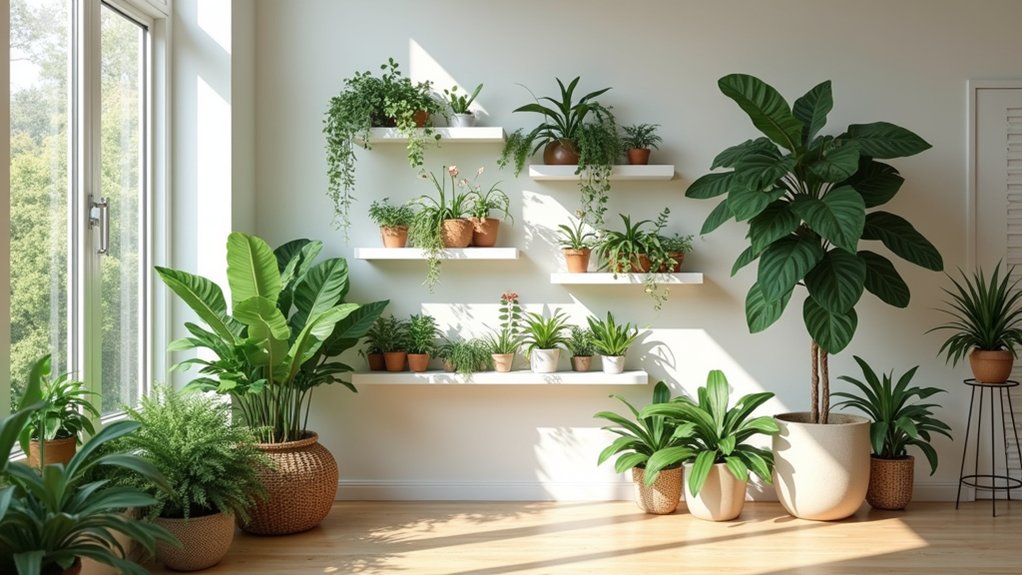
Creating visual height with multi-level displays transforms a sunroom from a flat, one-dimensional space into a dynamic environment with varying points of interest. This design approach involves arranging plants, furniture, and decorative elements at different heights using shelving units, plant stands, hanging baskets, and wall-mounted features. The layered effect draws the eye upward, making the room appear larger while maximizing available space for both plants and decor.
- Position taller elements against walls or in corners
- Place higher shelves in areas with strongest light exposure
- Ensure 12-18 inches of space between levels for plant growth
- Maintain proper air circulation between levels
- Consider weight capacity of shelving units and hooks
- Create contrast by mixing horizontal and vertical elements
- Alternate between dense and airy plant groupings
To maintain an effective multi-level display, rotate plants regularly to ensure even growth and prevent leaning toward light sources.
Regularly assess the stability of hanging elements and wall-mounted items, tightening hardware as needed. Clean shelving units and stands monthly to prevent pest issues and maintain air quality.
Adjust plant positions seasonally to accommodate changing light patterns and growth habits, while periodically editing displays to avoid overcrowding that can lead to poor plant health and visual clutter.
Mix Leaf Textures and Shapes for Interest
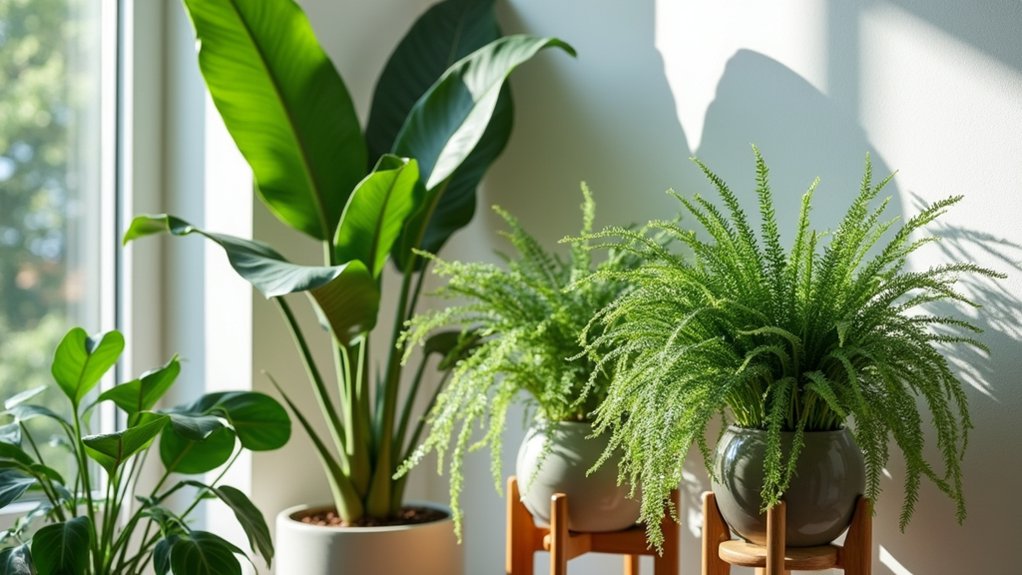
Mixing leaf textures and shapes creates visual depth and intrigue in your sunroom by combining plants with diverse foliage characteristics. Pairing broad-leafed plants like peace lilies with delicate, lacy ferns, or matching spiky snake plants with trailing pothos creates a dynamic interplay of forms. This layered approach adds dimension and prevents the space from feeling monotonous, while different leaf surfaces – glossy, matte, variegated, or textured – catch and reflect light in varying ways.
- Place plants with different light needs at appropriate distances from windows
- Group plants with similar water requirements together for easier maintenance
- Use well-draining potting mix suitable for each plant type
- Maintain consistent humidity levels between 40-60%
- Space plants to allow adequate air circulation
- Consider mature plant sizes when arranging different leaf types
To maintain a healthy mix of leaf textures and shapes, regularly rotate plants to ensure even growth and prevent reaching. Prune leggy growth and remove damaged leaves promptly to maintain attractive forms.
Clean leaves monthly with a damp cloth to remove dust and allow proper photosynthesis, paying special attention to textured surfaces where debris can accumulate. Monitor each plant’s individual growth patterns and adjust their positions seasonally to accommodate changing light conditions and maintain the desired visual balance.
Group Plants in Odd Numbers
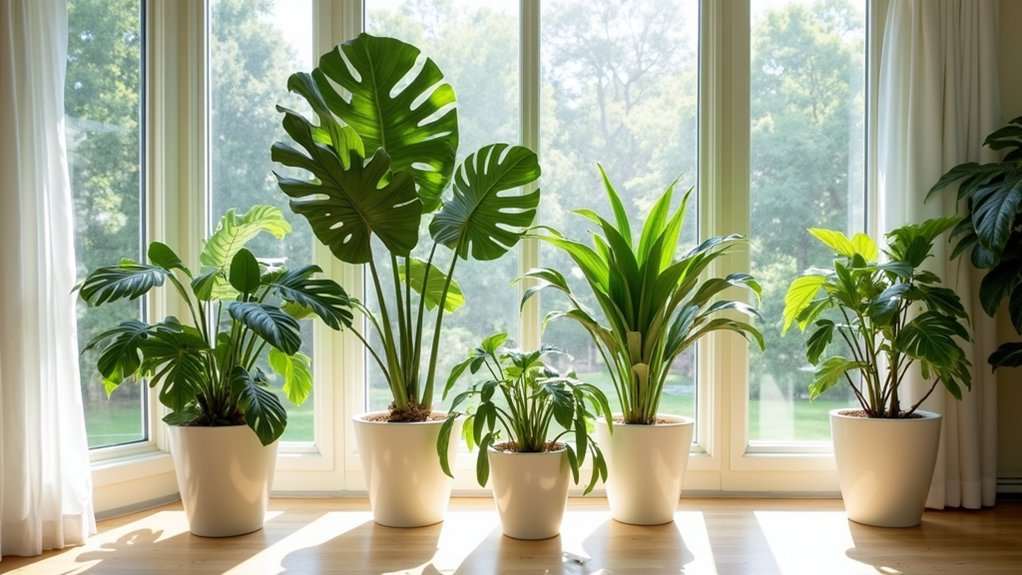
When styling plants in a sunroom, arranging them in odd-numbered groupings creates more visual interest and natural-looking displays than even-numbered arrangements. Groups of three, five, or seven plants appear more dynamic and pleasing to the eye, following a fundamental principle of design that odd numbers create asymmetrical balance.
This grouping technique works particularly well when combining plants of varying heights, textures, and shapes, allowing for a more organic and intentional aesthetic.
Key considerations for odd-numbered grouping:
- Space plants with enough room to accommodate their mature size
- Position taller plants toward the back or center of the grouping
- Maintain 2-3 inches between pots to allow for air circulation
- Choose plants with similar light and water requirements for easier care
- Consider using plants at different growth stages for varied heights
- Place smaller plants in front to create visual layers
To maintain attractive odd-numbered groupings, rotate plants quarterly to ensure even growth on all sides and prevent them from becoming leggy.
Regularly assess the arrangement’s visual balance, moving plants as they grow to maintain the intended design. When replacing plants that have outgrown their space or expired, select specimens that complement the existing grouping’s style while preserving the odd-numbered arrangement.
Incorporate Hanging Baskets and Trailing Vines
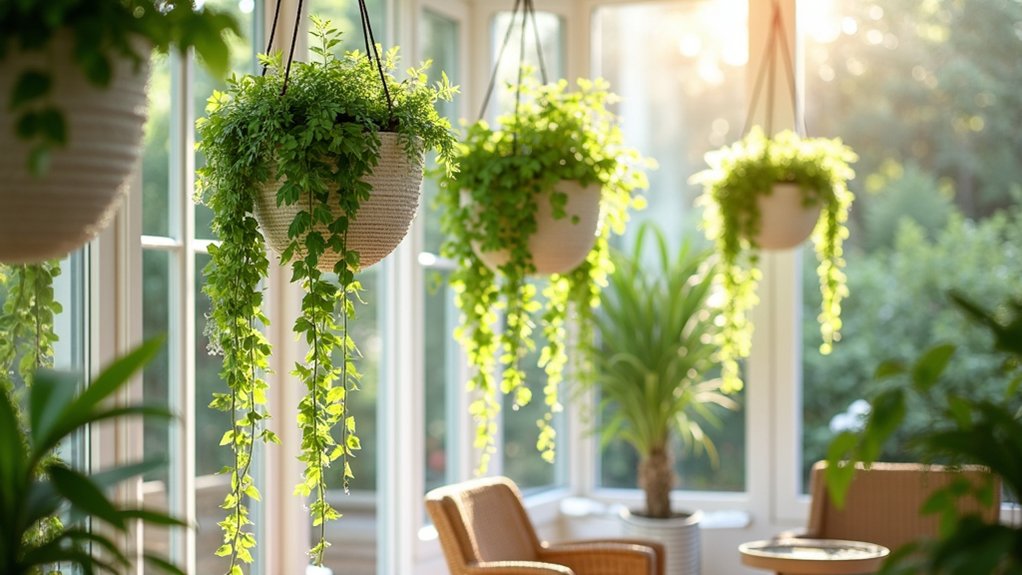
Hanging baskets and trailing vines add vertical interest and natural beauty to sunrooms, creating a lush, cascading effect that softens architectural lines and maximizes space utilization.
Popular trailing plants like English Ivy, Pothos, String of Pearls, and Boston Ferns create living curtains of greenery that can frame windows or create natural room dividers while purifying the air and adding tropical ambiance to the space.
- Light: Bright, indirect sunlight for most varieties; morning sun preferred
- Water: Keep soil consistently moist but not waterlogged; water when top inch feels dry
- Soil: Well-draining potting mix rich in organic matter
- Temperature: 65-80°F (18-27°C)
- Humidity: 50-60% for optimal growth
- Container: Lightweight hanging baskets with drainage holes
- Spacing: Allow 2-3 feet between plants for adequate air circulation
Regular maintenance of hanging baskets and trailing vines involves weekly grooming to remove yellowed or dead foliage, periodic trimming to control length and encourage bushier growth, and monthly fertilization during the growing season with a balanced, water-soluble fertilizer.
Rotate baskets quarter-turns weekly to ensure even growth, and inspect undersides of leaves for pests, particularly spider mites and mealybugs, which are common in indoor environments.
Define Zones With Strategic Plant Placement
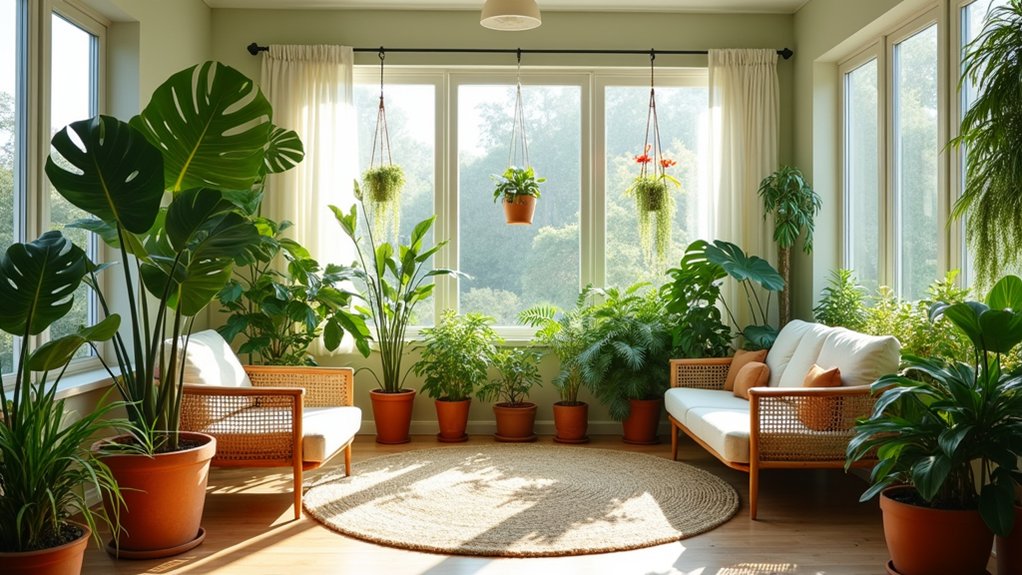
Strategic plant placement in a sunroom creates distinct functional areas while maintaining a cohesive flow throughout the space. Tall plants like fiddle leaf figs or bird of paradise can serve as natural room dividers, while cascading plants on elevated stands help define seating areas. Clustering plants of varying heights and textures around specific zones, such as a reading nook or meditation space, helps establish clear boundaries without the need for physical barriers.
- Light Requirements: Mix of direct and indirect sunlight depending on zone purpose; brightest areas for sun-loving plants, filtered light zones for shade-tolerant varieties
- Water Needs: Group plants with similar watering needs in the same zones for efficient maintenance
- Soil Type: Well-draining potting mix appropriate for each plant variety
- Temperature: 65-80°F (18-27°C), with good air circulation between plant groupings
- Humidity: 40-60% relative humidity, higher in tropical plant zones
- Spacing: 18-24 inches between large plants, 6-12 inches for smaller varieties
Regular rotation of plants ensures even growth and prevents stretching toward light sources. Monthly inspection of each zone helps identify any pest issues or growth problems before they spread to neighboring plants.
Prune and shape plants as needed to maintain defined boundaries between zones, and adjust plant positions seasonally to accommodate changing light patterns through windows. Clean leaves regularly to maximize light absorption and maintain the aesthetic appeal of each designated area.
Balance Large Statement Plants With Smaller Varieties

Creating visual harmony in a sunroom involves strategically mixing plants of different sizes, with large statement plants serving as focal points while smaller varieties add depth and texture. Tall, dramatic plants like fiddle leaf figs, bird of paradise, or monstera deliciosa can anchor corners or create natural dividers, while smaller plants like pothos, ferns, or succulents fill middle and lower spaces.
This layered approach prevents the space from feeling top-heavy or cluttered, instead creating a balanced, garden-like atmosphere.
- Light requirements: Mix of plants tolerant to bright, indirect light with some that can handle direct sun
- Water needs: Varied – group plants with similar watering needs together
- Temperature: 65-80°F (18-27°C) for most tropical and subtropical plants
- Humidity: 40-60% relative humidity
- Soil: Well-draining potting mix appropriate for each plant type
- Spacing: Allow 2-3 feet between large plants, 6-12 inches for smaller varieties
- Container sizes: Large plants need 12-24 inch pots, smaller plants 4-8 inch pots
Regular maintenance ensures both large and small plants thrive together in the sunroom ecosystem.
Rotate plants quarterly to ensure even growth and prevent leaning toward light sources. Prune larger specimens to maintain desired shape and size while pinching back smaller plants to encourage fullness.
Group plants with similar care requirements together to streamline maintenance, and implement a consistent inspection routine for pests, which can quickly spread in close plant communities.
Add Decorative Pots and Natural Elements
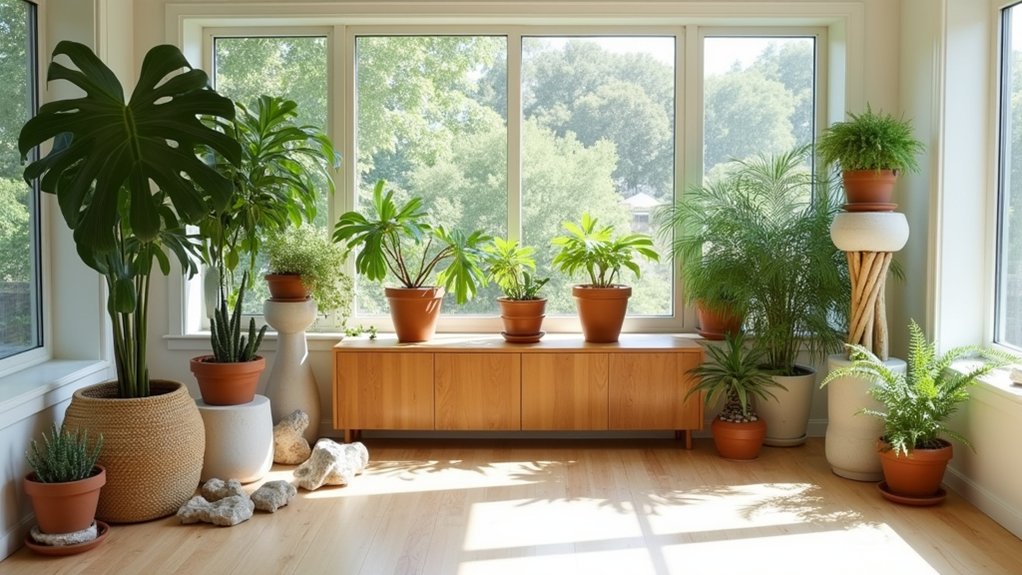
Decorative pots and natural elements bring the essence of the outdoors into your sunroom while adding visual interest and texture. Terra cotta, ceramic, or glazed containers in varying sizes and heights create dynamic groupings, while natural elements like driftwood, stones, or seashells add organic charm.
Combining different pot materials, colors, and designs with botanical elements creates layered vignettes that complement both the indoor and outdoor aspects of the space.
- Place pots in areas receiving appropriate light based on plant needs (most indoor plants prefer bright, indirect light)
- Use containers with drainage holes to prevent root rot
- Fill pots with well-draining, high-quality potting mix
- Group plants with similar water requirements together
- Position natural elements strategically to create focal points
- Consider seasonal rotations of decorative items to maintain fresh appeal
Regular maintenance of your decorative arrangements ensures lasting beauty and plant health. Dust both containers and natural elements monthly, rotate pots quarterly for even growth, and periodically assess containers for damage or mineral buildup.
Clean natural elements like shells or stones with a gentle brush, and refresh arrangements seasonally by introducing new elements or rearranging existing pieces. Consider treating outdoor items with a protective sealant to prevent weathering and maintain their aesthetic appeal.
